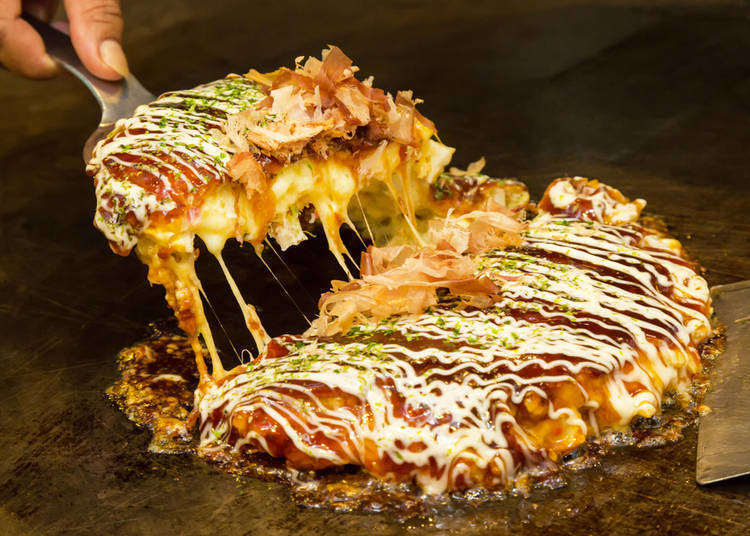
With so many delicious Japanese foods in Tokyo, narrowing it down to 25 is no easy feat. But here is our definitive list of 25 delicious must-eat foods in Tokyo!
Joshua Davenport / Shutterstock.com
Japan’s UNESCO-recognized cuisine is one of the primary reasons travelers descend upon the nation is such sizable numbers. Not only is the range of food types varied and dynamic, but many of them are the result of culinary artists perfecting their crafts over generations. From wavy noodles swimming in umami-pumped broths and raw fish that’s tender as butter to Osaka-style pancakes exploding with fillings and tare-smothered yakitori, the choices are an endless carnival of sensuous pleasure! Here are our favorites:
Noodles
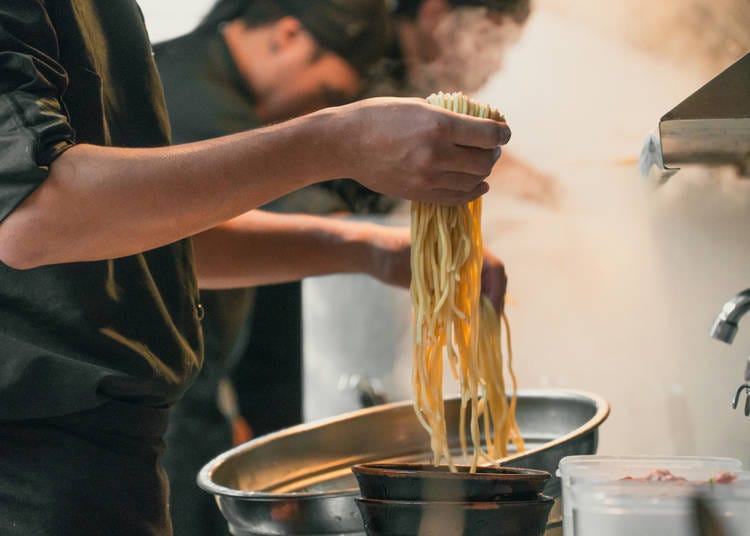
Noodles are, of course, one of the central pillars of Japanese cuisine culture, coming in a myriad of forms. They can be categorized by their thickness, their chijire (waviness), their taste properties, the dishes they appear in, and the ingredients from which they are made.
1. Ramen
Arguably the most popular of all Japanese foods, ramen is inseparable from Japan’s culinary world. Though the dish originated in China before being popularized in Tokyo in the early 1900s, eating it is thought a quintessential part of visiting Japan. Popular types include miso ramen, tonkotsu (pork bone) ramen, shoyu (soy sauce) ramen, spicy ramen, chicken ramen, and tsukemen (noodles with dipping sauce).
-

-
Address
The Tokyo Station first Avenue the first floor of the basement south street, 1-9-1, Marunouchi, Chiyoda-ku, Tokyo, 100-0005
View Map -
Nearest Station
Tokyo Station (Tokaido Shinkansen Line / Hokkaido Shinkansen Line / Tohoku Shinkansen Line / Akita Shinkansen Line / Yamagata Shinkansen Line / Joetsu Shinkansen Line / Hokuriku Shinkansen Line / JR Tokaido Main Line / JR Yokosuka Line / JR Sobu Main Line / JR Sobu Main Line (Rapid) / JR Keihin-Tohoku Line / JR Yamanote Line / JR Chuo Main Line / JR Keiyo Line / JR Ueno Tokyo Line / Tokyo Metro Marunouchi Line)
1 minute on foot
- Phone Number 03-3210-0077
-
Address
The Tokyo Station first Avenue the first floor of the basement south street, 1-9-1, Marunouchi, Chiyoda-ku, Tokyo, 100-0005
2. Soba
Soba, made from buckwheat, are chewy noodles often served cold with a salty tsuyu dipping sauce alongside spring onions, chopped nori seaweed and wasabi. Popular accompaniments include vegetable or seafood tempura. The two main branches of soba are: zaru soba (served cold, often on bamboo platter) or kake soba (served hot in a soupy broth).
3. Udon
Udon noodles are distinctive due to their thickness and super soft texture, and much like soba, are served both hot and cold. Udon has been eaten in China since 700, and gained culinary fame in Japan some 1,000 years later; that’s a long time for artisans to be iterating upon the craft. Hot udon, in a dashi (fish stock) and soy sauce broth called kakejiru, or alongside a Japanese curry dipping broth are optimal ways to eat the dish. Cold udon with a light broth is also popular in summer.
Street Food
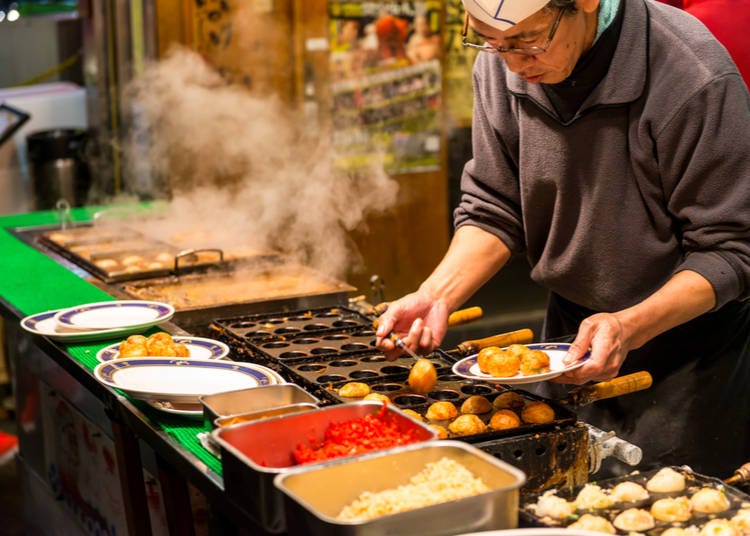
With limited space and social taboos on eating while walking, it's surprisingly not the easiest to find street food in Japan. But when you do, it's well worth it! You can even find great street food at local festivals and even in restaurants if you know where to look.
4. Gyoza
One cannot journey to the Japanese capital without chowing down on some gyoza dumplings. Originally a Chinese dish before the Japanese began to embellish it, gyoza are made from flour wrapped around spiced, ground meat and vegetables in a distinctive crescent moon shape. Be sure to eat with a fresh pint of beer.
5. Takoyaki
Takoyaki are a distinctly modern Japanese creation: battered chunks of octopus smothered in tare barbecue sauce, mayonnaise and katsuobushi (bonito flakes). Though Osaka is the home of the dish, Tokyo has no shortage of places to find these wholesome, little bites, particularly at annual festivals and the frequent stalls near Asakusa’s Senso-ji temple and Ueno Park.
6. Taiyaki
Taiyaki are named for what they look like, rather than how they taste. These “tai-” (sea bream) shaped pastries are like pseudo-pancakes filled with sweet bean paste, custard or chocolate, and sometimes come in a green matcha-flavored batter. Generally they are sold at hole-in-the-wall shops on street corners, and at festivals and markets.
7. Dango
Dango are sticky mochi rice balls on a stick, also coming in matcha and plain variations. Typically they are topped with a sweet tare sauce, or red bean paste. They are often sold at markets and festivals, especially in spring when they come in pink, green and white to reflect the seasons colors.
Seafood
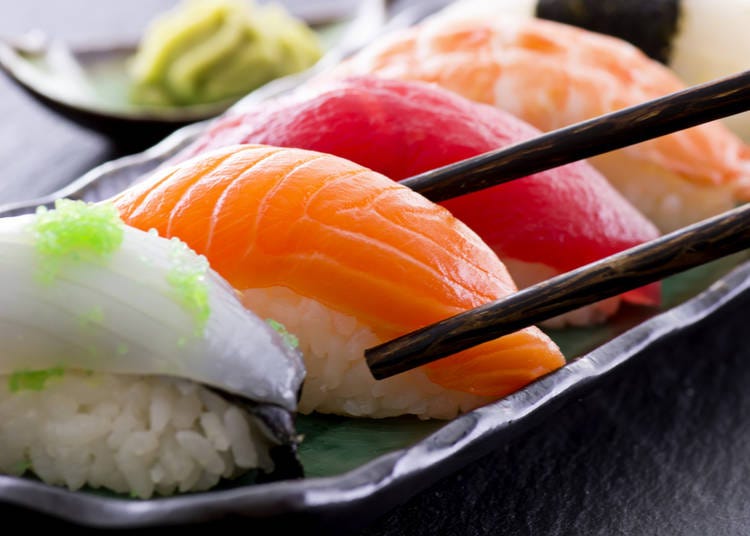
As an island, Japan is endowed with a mouthwatering raft of aquatic produce, from shellfish and underwater molluscs to tuna, salmon, eels, and just about everything in between. The variety of fish on offer, not to mention the different ways in which they are prepared, can be overwhelming. But there are some types of Japanese seafood you just can’t skip out on in Tokyo. Tsukiji outer market and Toyosu fish market are two of the best places on the planet to sample fresh Pacific Ocean catch, along with a raft of accolade-showered restaurants across the capital.
8. Tempura
Tempura is one of Japan’s most famous culinary techniques, referring to the light, lumpy batter used to deep fry a variety of foods; shellfish, like prawns, squid and scallops are some of the most common. In Japan seafood tempura usually comes with a lightly salted tentsuyu dipping sauce and crushed daikon radish, with rice or soba on the side.
9. Sushi
Sushi is the epitome of Japanese seafood. Simple yet elegant, it’s raw fish served on a bed of room temperature rice - the short-grain rice served with seasoned vinegar is actually where the cuisine gets its name from. Tuna is one of the most popular sushi fish coming in many varieties dictated by the levels of fat within it, but uni (sea urchin), salmon, bluefin, mackerel, yellow tail and host of seasonal specials are also must-eats. Michelin-starred sushi can be found in districts all over Tokyo, but kaiten (conveyor belt) sushi shops are great affordable alternatives.
10. Sashimi
Sashimi is sushi’s less popular but equally delicious cousin, where the raw fish is served on a platter of crushed ice (to keep it cool) rather than on vinegared rice. Common accompaniments are shiso (Japanese basil/beefsteak planet), sliced daikon radish, soy sauce and wasabi.
11. Unagi
The word unagi may have been popularized by the TV sitcom Friends, but it actually means ‘freshwater eel’ in Japanese. Eel is seen as a refined form of seafood dining in the Land of the Rising Sun, often coming in crafted wooden boxes with rice and a sweet wine and soy sauce marinade. Unagi is also sold on skewers at Tokyo’s fish markets.
Soul Food
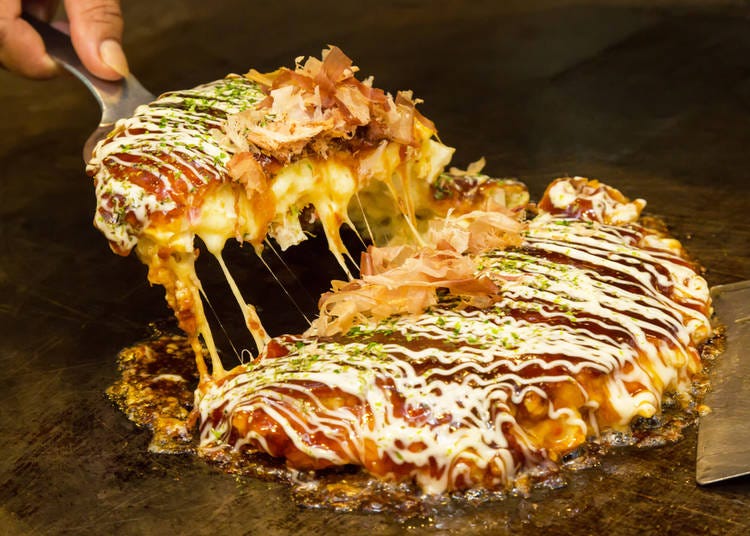
Japanese soul food is a specialty in the western metropolis of Osaka, but as Tokyo is the culinary center of the country, it has become equally popular in the capital. Soul food is heavy, wholesome cuisine; the sort of food that clears away your hangover. And is much more representative of modern Japanese cooking techniques, than the simplistic traditional cuisine the country is renowned for.
12. Okonomiyaki
Okonomiyaki is a savory pancake-cum-omelet, sometimes called an Osaka pancake, that literally translates to “what you like, cooked”. At many restaurants you’ll cook okonomiyaki yourself at hot plates built into the table. A bowl is filled with eggs, flour, cabbage and toppings of your choice; simply mix them around, dump them onto the grill, and let the heat do the rest. Once ready, top with tare sauce, mayonnaise and katsuobushi flakes; and voila, hangover eradicated.
13. Monjayaki
Monjayaki is very similar to okonomiyaki, but with more water and less flour added to the initial mixture. Tastewise they are very similar, but ‘monja’ has more of a gelatinous texture. It is particularly popular in the Kanto region, comprising Tokyo and six other prefectures. So where better to try monjayaki than the hometown of the dish?
14. Tonkatsu
Tonkatsu is a breaded pork cutlet - a super popular dish in Nagoya, Aichi Prefecture, when served with a sweetened miso sauce. Though many restaurants in Tokyo will serve it with rice, salad and Japanese curry sauce, hole-in-the-wall shops also serve it as is to be eaten on the go.
Izakaya Staples

Izakaya are Japanese gastropubs, usually with their own culinary specialities - meat skewers, fried chicken, marbled beef, battered vegetables - and are probably the most common dining option in Japan. Since the Meiji Emperor lifted Japan’s 1,200-year ban on eating meat in 1872, grilled meat cuisine has become increasingly more prevalent, particularly with the introduction of western cooking techniques - these often come to the fore in izakaya. The Japanese have been perfecting the meaty crafts since then, with beef and chicken in particular elevating the umami food scene to unparalleled heights.
15. Yakitori
Literally meaning ‘grilled chicken’, yakitori is one of the most common food types in Tokyo. Salarymen pile into yakitori restaurants during the week en masse to take down skewers of chicken, from thighs and breasts to cartlidge and hearts. Yakitori is cooked with two main flavorings: tare (barbecue), shio (salt).
16. Yakiniku
Yakiniku (grilled meat) restaurants are a perfect showcase for the wonders of Japanese wagyu beef. Most outlets will provide grills at the table and serve thin slices of raw beef on platters for you to cook yourself. Japanese beef is typified by the marbly veins of fat coursing through it, which are so packed with flavor that they are hard to overcook. Dipping sauces will vary from spot to spot, but soy sauce, yuzu (citrus) and chili, sesame, and wasabi are all common fixtures.
17. Kushiage and Kushikatsu
Kushiage are deep-fried vegetable skewers served with dipping sauces - as with most fried foods in Japan, tare is a popular condiment. There are no specific rules as to which veg should be used, so everything from lotus root, asparagus and eggplant to tomatoes, sweet potatoes and onions can make an appearance. Kushikatsu is conceptually similar, but it’s not one for the vegetarians; it’s deep fried pork cutlet (‘kushi’ means skewer, ‘katsu’ means cutlet).
18. Karaage
Karaage is a fine example of Japan’s mastery of cooked chicken. The dish of battered chicken thighs sounds simple, but when combined with a little lemon and mayonnaise, and accompanied by an ice cold draft, there are few cheap bites in the nation that compare. The use of chicken thigh when making karaage helps retain much of the flavor packed in the rivulets of fat running through it, while the light batter and oils used to fry the meat prevent it from becoming too heavy.
Hotpot

Hotpots are common all across Asia, and true to reputation the Japanese have also got in on the action. Japanese-style hotpots usually simmer on a convection hob in the middle of the restaurant table, so you can add in a range of meat and veg as you please.
19. Nabe
Nabe, or more specifically chanko nabe, is the food of the sumo wrestlers, cooked by the gargantuan competitors for each other in the ‘stables’ where they live and train. Chanko nabe is, naturally, filled with a wide range of toppings, including chicken, pork, fish, mushrooms, tofu, udon and more, swimming in a salty broth. Korean-style kimchi nabe, and tofu nabe (great for vegetarians) are other top-sellers.
20. Sukiyaki
Sukiyaki is sometimes called ‘The King of Nabe’: an iron pot filled with wagyu beef and vegetables simmering in a sweet warashita broth of soy, mirin and sugar. It’s a savory dish, but a little sweeter than its hotpot counterparts.
21. Shabu shabu
Shabu shabu is popular with foreigners, and can be thought of as ‘dipping nabe’. The hotpot is filled with a sauce of your choice, tofu and vegetables, into which thin sliced meat is dipped. The name ‘shabu shabu’ is onomatopoeic, reflecting the sound of the ingredients when stirred in the pot.
Meat and Rice
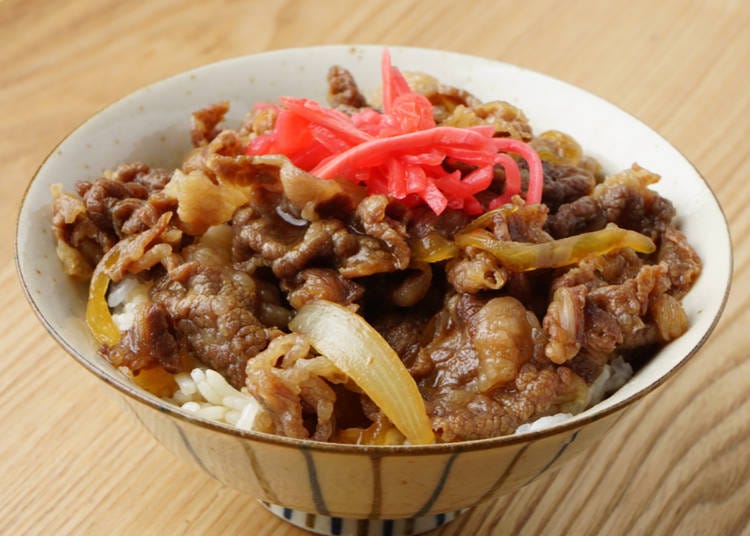
Meat and rice dishes typically fit into the Japanese fast food category, with a host of beef bowl chains and cheap curry houses peppering the archipelago. Tokyo, as with most foodstuffs, has the highest concentration of these shops within its limits.
22. Curry Rice
Curry rice, known by its Japanese-English name ‘kare raisu’, is exactly what it claims to be. Initially created by the imperial army to prevent beriberi in the late 1800s, the dish is composed of plain rice served with a brown-tinged curry sauce that fuses Japanese flavors and Indian spices. Its taste is sweeter than most Asian curries, but in appearance it resembles a British stew, with chunks of meat, carrots and potatoes (though it can easily be made vegetarian as well).
23. Beef Bowl
Beef bowl, or ‘gyudon’, is one of the most commonly eaten dishes in Tokyo, as cheap chain stores fill up at a rate of knots during the weekly lunch hours. Delicious simplicity is the key here: a bowl of rice is topped with thin beef and sliced onions simmered in a mildly sweet sauce. Crowned with a soft boiled egg and some pickled ginger, you’ll be hard pushed to find a better lunch at such a reasonable price.
(The below spot is outside of Tokyo, but there are plenty of the same chain within the Tokyo metropolitan area too!)
-
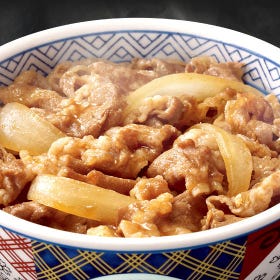 YOSHINOYA Naritakokusaikukodainisateraitoten吉野家 成田国際空港第2サテライト店
YOSHINOYA Naritakokusaikukodainisateraitoten吉野家 成田国際空港第2サテライト店-
Address
Second terminal building south terrace 3F80 turn concourse F3100,1-1, Furugome, Narita-shi, Chiba, 286-0104
-
Nearest Station
Airport Terminal 2 Station (JR Narita Line / Keisei Main Line / Narita SKY ACCESS Line)
-
Address
Second terminal building south terrace 3F80 turn concourse F3100,1-1, Furugome, Narita-shi, Chiba, 286-0104
Traditional Cuisine

Though we have touched on various foods that fall under the category of ‘traditional cuisine’ kaiseki ryori and shojin ryori - ‘ryori’ means cooking - are the two that embody Japan’s food heritage the most. They are definitely toward the high-end of the spectrum, but to understand why Japanese food is so respected globally, they are the perfect entry points.
24. Kaiseki Ryori
Kaiseki ryori is a multi-course, seasonal meal featuring a procession of small, delicate dishes with each one's flavor profile blending into the next. It is eating as an experience, and it's an experience that is practically impossible to replicate outside Japan. Dishes will range from raw fish and boiled veg to rich umami meats and miso soup with rice; ordering and ingredients will depend on the time of year and the chef’s intuition.
25. Shojin Ryori
Shojin ryori is a humbler version of its kaiseki cousin; the food of the zen monks. Said monks do not believe in taking life, so shojin ryori is an entirely plant-based repast featuring around five small dishes served together with rice, miso soup and a light seasonal fruit dessert. Though the temples of Kyoto are renowned for their shojin cuisine, Tokyo is not without its fair share.
A Little Appetizer!
We could go on and on, with hundreds if not thousands of entries. But if there is a definitive list of Japanese foods you must try in Tokyo, the above 25 are it. Be sure to travel on an empty stomach!
- Area
- Category
*Prices and options mentioned are subject to change.
*Unless stated otherwise, all prices include tax.
Recommended places for you
-

Ginza Tosaryori Neboke
Japanese cuisine
Ginza
-

Hanamicyou
Japanese cuisine
Harajuku
-

Oto-Oto Ikebukuro
Japanese cuisine
Ikebukuro
-

Akasaka Tosaryori Neboke
Japanese cuisine
Roppongi
-
Menu

Ganso Kamameshi Haru
Japanese cuisine
Asakusa
-

NIIGATASADONOSYUNTOJIZAKENODOGURONOAKUBIOKACHIMACHI
Japanese cuisine
Ueno
-

2025 Japan Cherry Blossom Report: Tokyo At Peak Bloom
-
Ad

Hungry in Ikebukuro? 9 Must-Try Restaurants at 'Dining City SPICE' at Tobu Department Store
-

It's Official! Tokyo's Cherry Blossom Season Began Today (March 24)
-
Ad

What to Eat on Your Japan Trip? Tonkatsu and Ramen Would Be Your Best Bet!
-
Ad

Discover Fukuoka: The Compact, Eco-Conscious City Leading Sustainable Travel
-

Save Time & Make Cooking Easier! 5 Must-Have DAISO Kitchen Gadgets Recommended by a Japanese Mom
Inspiration for Accommodations
-

Enjoy Mt. Fuji from the Comfort of Your Room! Recommended Ryokan with Mt. Fuji View
-

Stay Near the Cherry Blossoms! Hotels for Cherry Blossom Viewing in Tokyo
-

Family-Friendly Hotels with Free Shuttle to Disneyland: Convenient Access for a Magical Stay
-

Top Ranked Hakone Hotels with Mt. Fuji View: Enjoy Stunning Scenery from Your Private Space
-

Convenient Tokyo Hotels with Airport Shuttle: Ideal for Families and Heavy Luggage
-

Stunning Tokyo Tower View Hotels: Enjoy Spectacular Scenery from Your Private Space
-

Convenient Asakusa Hotels with Kitchens: Ideal for Extended Family Visits
-

Experience Luxury: Hakone's 10 Best Five-Star Accommodations
-

Enjoy Mt. Fuji Autumn Leaves! Top Hotels Near the Popular Autumn Leaves Corridor
-

Experience Hakone Fall Foliage from Your Room with Stunning Views
-

Ueno Station Area Guide: Fun Ways to Explore Tokyo's Popular Destination (Area Map & Sightseeing Tips)
-

Kita no Kuni Bar in Shinjuku – Feasting on Fresh Hokkaido Delicacies in the Heart of Tokyo!
-
Ad

5 Authentic Japanese Rice Recipes That’ll Make Your Cooking Healthier, More Incredible!
-

Sachi no Otera Gohan: Discovering the Amazing World of Japanese and Buddhist Cuisine by Manga
-

Top 4 Go-To Spots for Tokyo Ramen
-

(Video) Walking Tour along Narita Omotesando - Quaint Historical Village near Narita Airport!
by: Victor Gonzalez
- #best ramen tokyo
- #what to buy in ameyoko
- #what to bring to japan
- #new years in tokyo
- #best izakaya shinjuku
- #things to do tokyo
- #japanese nail trends
- #what to do in odaiba
- #onsen tattoo friendly tokyo
- #daiso
- #best sushi ginza
- #japanese convenience store snacks
- #best yakiniku shibuya
- #japanese fashion culture
- #best japanese soft drinks















